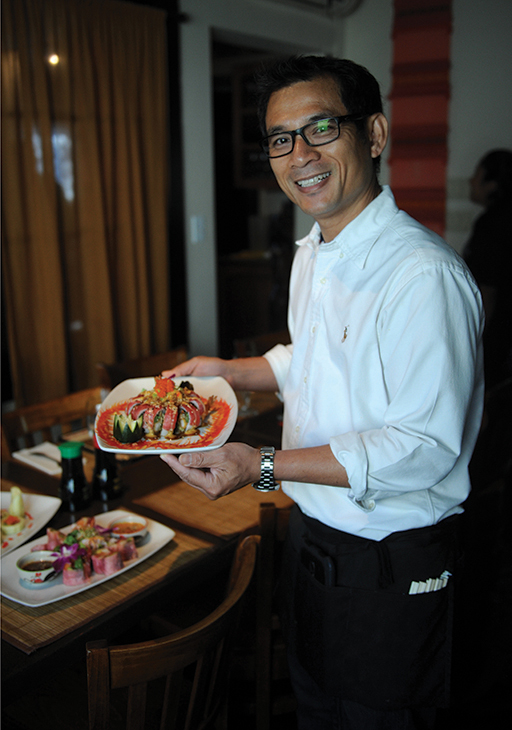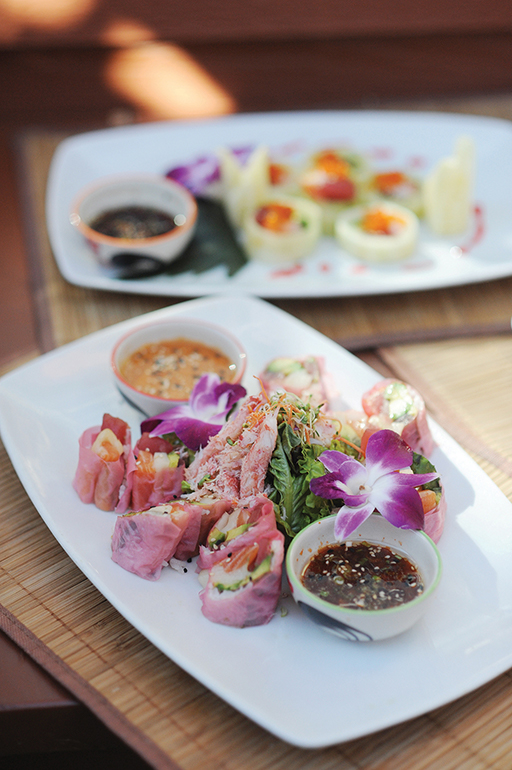Keeping in mind that the resort town of Sun Valley and its surrounding communities are landlocked, one might not naturally associate the Wood River Valley with top-of-the-line sushi. But hold on to your chopsticks—this dynamite mountain town destination has more than endless recreational pursuits and Rocky Mountain fare. Perfectly sliced hamachi? Expertly crafted sushi rolls with eel sauce and fresh salmon? Absolutely. The Japanese-style fare has earned its seat at the epicurean table, with an array of restaurants and markets serving up the cuisine boasting a cult-like following.
Whether you’re a wasabi fanatic, an adventurous eater, or a nigiri neophyte, there is bound to be a roll or two (or four!) that will satiate your palate. The creative, regional sushi chefs at Zou 75 and Dang’s in Hailey, or Sushi on Second in Ketchum, and Atkinsons’ Markets in both towns, are crafting authentic rolls and mouth-watering sashimi. What’s more, they take their profession very seriously. It is an art form, after all.
“I am amazed by the way the chefs put the components together and create the final product,” said Maryls Ivie, the deli manager at Atkinsons Market. “The sushi here is really colorful and beautiful.”
The secret to the art in raw-fish-form? The rice is a key component. But whether you’re hankering for sashimi (thin cuts of raw fish), nigiri (fish served over pressed rice), temaki (sushi rolled into a cone shape), or uramaki (a sushi roll with the rice on the outside), the fish is always the star.

Owner Dang shows off one of his chef’s creations.
Tucked away off Second Street in downtown Ketchum, and owned by Roger and Jill Roland and their partner Paige Lethbridge, Sushi On Second has been delighting taste buds with fresh fish dipped in soy sauce or topped with wasabi since 1994. A Southern California native and a glass blower by vocation, Roland happened into the restaurant business after a friend approached him about opening a sushi bar. After a stint in Hawaii, Roland unearthed a fervent love of the cuisine and decided to dive in and help bring the delicacy to Idaho.
“I grew up in Southern California and after high school in 1967, I followed the big wave to Maui,” he said. “I had never had sushi in my life, but one day these fisherman said, ‘Here, want to try this?’ It was raw sashimi Blue Fin Ahi. I thought, ‘This is how fish should taste, just like the ocean.’”
Fast forward to 2017, sushi lovers flock to the quaint, comfortable restaurant to see what Rust is creating, whether it’s the regular menu or the not-so-secret off-menu rolls. Rust and Brenda Griffin, also a sushi chef at Sushi On Second, both agree that the key to sushi is equal parts rice and fish.
Contrary to what many sushi diners might think, the word does not mean raw fish. Sushi means vinegared rice.
“It has to be done right; at the right temperature to get the right consistency,” Roland explained.
For Rust and Griffin, the daily process takes two and a half hours to reach sticky rice perfection. On a busy winter day, the crew at Sushi On Second might go through 40 to 50 pounds of tuna and 180 cups of rice, which requires three different batches throughout the evening.
“It starts with a medium grain sushi rice, or a white rice that is rinsed for about a half an hour to remove the starch. Then, we cook it in a rice cooker that can cook up to 50 cups at a time,” Rust said. “After, you mix it with the seasoned rice vinegar and let it cool just enough to where it is right above room temperature. If it gets too cold, the rice becomes tacky and lacks flavor.”
When you are left with warm, pliable sticky rice, you are ready to begin your roll.
“The rice adds a texture and a little bit of sweetness from the vinegar, sugar, and salt that complements but does not take away from the fish. Sushi is all about balance,” Rust said.
Every sushi chef must learn how to execute this balance, like the size of each ingredient, the flavor combinations, and the thickness of the rice. Rust learned to craft sushi using traditional styles and methods.
In Japan, a typical sushi roll would highlight a single fish with cucumber wrapped in seaweed. Western-style sushi has taken some creative license, adding mayo-based sauces, fish combinations, and new vegetables and flavors. You might find Rust’s homemade citrus-infused ponzu sauce or his smoked habanero hot sauce, but beyond a tweak here and there, they put the emphasis on the fish. Rust focuses on sushi’s “big three” fish: salmon, hamachi (yellow tail), and tuna.
And when filleting the fish, Rust and Griffin look to their trusty Japanese sushi knives.
“Cutting fish for me was the most interesting thing to learn and the most difficult,” Rust said. A classically trained chef, Rust learned to fillet holding the knife away from his body like most Western chefs. He began his culinary journey at a steak and seafood restaurant, then moved to Paris to pursue other gastronomic endeavors. But when he ended up back in Sun Valley and found himself at Sushi On Second, he had to unlearn many knife skills he already had.
Japanese chefs cut toward themselves and catch the fish filets. The act is a slicing motion, versus a saw-like style used to cut most meat.
“We use the entire blade to cut through the fish. That way, it doesn’t leave any marks on the fish, and it is just clean. It looks like a natural piece that fell off,” he said.
A chef might spend a year perfecting each technique before moving on to the next.
“Here I am 15 years later, and I am still learning. With sushi, we all are. There is always something new to learn or try,” Rust said.
And if you’re unsure what roll you might like or even if you like sushi at all? Grab a seat at the sushi bar and ask the chef. They are sure to know a thing or two.


